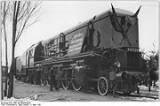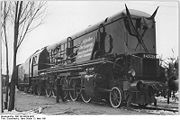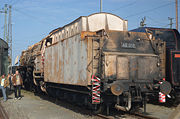
DRG Class 45
Encyclopedia
German Class 45 steam locomotives were standard locomotives (Einheitslokomotive
n) designed by the Deutsche Reichsbahn
for hauling goods trains.
n. The Class 45s were given the operating numbers 45 001 - 45 028.
After the war, boiler damage appeared very quickly that made a reduction of the boiler
overpressure
to 16 bar necessary. From 1950 therefore several Deutsche Bundesbahn
machines were equipped with an outer firebox with a combustion chamber and a mechanical underfeed stoker (Rostbeschicker). The engines with operating numbers 45 010, 45 016, 45 019, 45 021 and 45 023 were provided with welded boilers and underfeed stoker equipment.
The engine rebuilt by the Deutsche Reichsbahn in East Germany into high pressure variant with operating number 45 024 (called the H 45 024) was a failure and was retired in 1959. Parts of this locomotive (outside cylinders
, trailing wheels and the rear section of the locomotive frame
) were used in building engine no. 18 201
.

 In 1968 the Deutsche Bundesbahn only had three examples left, which were used as braking and experimental engines by the Bundesbahn Central Office in Munich
In 1968 the Deutsche Bundesbahn only had three examples left, which were used as braking and experimental engines by the Bundesbahn Central Office in Munich
and Minden
. They were no. 45 023, which was stabled in Munich, and nos. 45 010 and 45 019, which were stationed at Minden. On the evening of 17 October 2005 a fire destroyed the locomotive shed of the Nuremberg Transport Museum
in Nuremberg, as a result of which the last preserved example of this class, the 45 010, was badly damaged. It is planned to restore it.
This class was initially a faulty design, similar to the DRB Class 06, because of its poor boiler. Following replacement of the boiler and the introduction of mechanical stoking the true qualities of this locomotive became clear. As well as being used as braking locomotives for the Bundesbahn Central Office, in their final years numbers 45 019 and 45 010 used time and again for those heavy goods train duties that the Class 44
locomotives had difficulties with.
The vehicles were coupled with 2'3 T 38 tenders
. Those with underfeed stokers had 2'3 T 29 Stoker tenders.
Einheitsdampflokomotive
The German term Einheitsdampflokomotive, sometimes shortened to Einheitslokomotive or Einheitslok, means standard steam locomotive and refers to the steam engines built in Germany after 1925 under the direction of the Deutsche Reichsbahn-Gesellschaft...
n) designed by the Deutsche Reichsbahn
Deutsche Reichsbahn-Gesellschaft
The Deutsche Reichsbahn – was the name of the German national railway created from the railways of the individual states of the German Empire following the end of World War I....
for hauling goods trains.
History
The Class 45 engines were the most powerful steam locomotives ever operated in Germany. They were built between 1936 and 1937 by the firm of Henschel. After the first two engines entered service, a further 26 units were delivered in 1940. However, the third order for another 103 machines was cancelled in 1941, because the outbreak of the Second World War favoured the construction of simpler wartime locomotives, the so-called KriegslokomotiveKriegslokomotive
Kriegslokomotiven were German 'war locomotives', produced in large numbers during the Second World War, whose construction was tailored to the economic circumstances of wartime Germany, such as shortages of materials, goods transportation , ease of maintenance under difficult conditions, resistance...
n. The Class 45s were given the operating numbers 45 001 - 45 028.
After the war, boiler damage appeared very quickly that made a reduction of the boiler
Boiler
A boiler is a closed vessel in which water or other fluid is heated. The heated or vaporized fluid exits the boiler for use in various processes or heating applications.-Materials:...
overpressure
Overpressure
The term Overpressure is applied to a pressure difference, relative to a "normal" or "ambient" pressure, in various circumstances:* In engineering: the pressure difference over the wall thickness of a pressure vessel...
to 16 bar necessary. From 1950 therefore several Deutsche Bundesbahn
Deutsche Bundesbahn
The Deutsche Bundesbahn or DB was formed as the state railway of the newly established Federal Republic of Germany on September 7, 1949 as a successor of the Deutsche Reichsbahn-Gesellschaft '...
machines were equipped with an outer firebox with a combustion chamber and a mechanical underfeed stoker (Rostbeschicker). The engines with operating numbers 45 010, 45 016, 45 019, 45 021 and 45 023 were provided with welded boilers and underfeed stoker equipment.
The engine rebuilt by the Deutsche Reichsbahn in East Germany into high pressure variant with operating number 45 024 (called the H 45 024) was a failure and was retired in 1959. Parts of this locomotive (outside cylinders
Cylinder (steam locomotive)
The cylinders of a steam locomotive are the components that convert the power stored in the steam into motion.Cylinders may be arranged in several different ways.-Early locomotives:...
, trailing wheels and the rear section of the locomotive frame
Locomotive frame
A locomotive frame is the structure that forms the backbone of the railway locomotive, giving it strength and supporting the superstructure elements such as a cab, boiler or bodywork. The vast majority of locomotives have had a frame structure of some kind...
) were used in building engine no. 18 201
DR 18 201
The German express locomotive, number 18 201 of the Deutsche Reichsbahn in East Germany, appeared in 1960-61 at Meiningen repair shop as a conversion of the Henschel-Wegmann train locomotive 61 002, the tender from 44 468 and parts of H 45 024 and Class 41...
.


Munich
Munich The city's motto is "" . Before 2006, it was "Weltstadt mit Herz" . Its native name, , is derived from the Old High German Munichen, meaning "by the monks' place". The city's name derives from the monks of the Benedictine order who founded the city; hence the monk depicted on the city's coat...
and Minden
Minden
Minden is a town of about 83,000 inhabitants in the north-east of North Rhine-Westphalia, Germany. The town extends along both sides of the river Weser. It is the capital of the Kreis of Minden-Lübbecke, which is part of the region of Detmold. Minden is the historic political centre of the...
. They were no. 45 023, which was stabled in Munich, and nos. 45 010 and 45 019, which were stationed at Minden. On the evening of 17 October 2005 a fire destroyed the locomotive shed of the Nuremberg Transport Museum
Nuremberg Transport Museum
The Nuremberg Transport Museum is based in Nuremberg, Germany, and consists of the Deutsche Bahn's own DB Museum and the Museum of Communications . It also has two satellite museums at Koblenz-Lützel and Halle...
in Nuremberg, as a result of which the last preserved example of this class, the 45 010, was badly damaged. It is planned to restore it.
This class was initially a faulty design, similar to the DRB Class 06, because of its poor boiler. Following replacement of the boiler and the introduction of mechanical stoking the true qualities of this locomotive became clear. As well as being used as braking locomotives for the Bundesbahn Central Office, in their final years numbers 45 019 and 45 010 used time and again for those heavy goods train duties that the Class 44
DRG Class 44
The Class 44 was a ten-coupled, heavy goods train steam locomotive built for the Deutsche Reichsbahn as a standard steam engine class . Its sub-class was G 56.20 and it had triple cylinders...
locomotives had difficulties with.
The vehicles were coupled with 2'3 T 38 tenders
Tender locomotive
A tender or coal-car is a special rail vehicle hauled by a steam locomotive containing the locomotive's fuel and water. Steam locomotives consume large quantities of water compared to the quantity of fuel, so tenders are necessary to keep the locomotive running over long distances. A locomotive...
. Those with underfeed stokers had 2'3 T 29 Stoker tenders.
Literature
- B. Seiler / Jürgen U. Ebel Die Baureihe 45, EK-Verlag, Freiburg 2006, ISBN 978-3-88255-151-8
External links
- There is a relevant English-language forum at Railways of Germany

